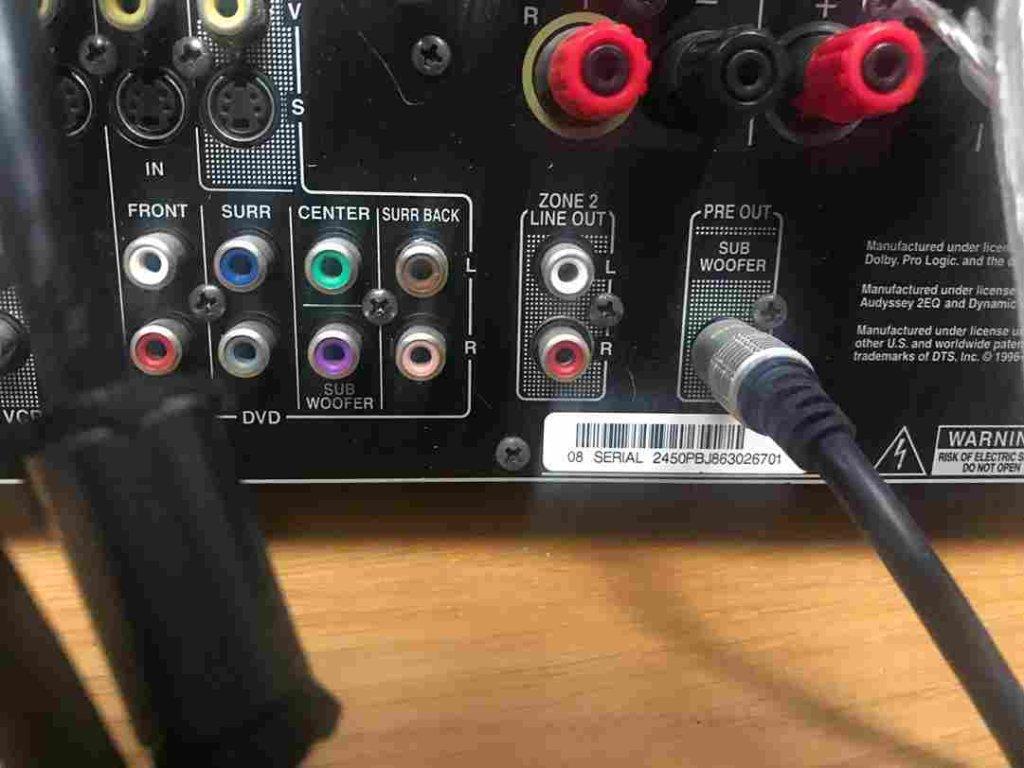Subwoofer Pre-Out: If you want to hook up a powered or active speaker and subwoofer from an outside foundation, you’ll need a subwoofer pre-out. The receiver’s great feature is that the subwoofer can be powered directly through the port, bypassing its amplifier. Most premium receivers feature three pre-outs: one for the amplifier and two for the subwoofer. Having this option means that you can hook up the speaker and subwoofer at the same time.
The abbreviation for “pre-output” is “pre-out.” They help you add more channels to your home theatre setup and are typically paired with a subwoofer. The preamp’s output allows for some serious upgrading possibilities.
It bypasses the amplifier’s power stage while still extracting the signal. Furthermore, the chief organized unit is a stereo or home theatre system’s handset. Before the signal is amplified and sent to the loudspeaker, a preamplifier provides an equivalent output.
An analog audio output, pre-out, can be adjusted for volume and switched between input sources. It allows the indication to pass through and be amplified by another means. Includes all the channel volume and EQ processing in the preamp stage. The receiver handles the complex work of selecting sources, adjusting volumes, and implementing digital signal processing and other effects. At the same time, the power amplifier is responsible for nothing more than driving the speakers. This port can replace an external unit’s internal power amplifier. If your subwoofer has its amplifier built-in, you can use the pre-outs to connect them.
Check also: Best Budget Subwoofers
Table of Contents
A preamp’s output and how to put it to use
To begin, you must decide whether or not your speakers will be powered by the receiver’s internal amplifier or by an external amplifier. Locating the receiver’s pre-out connection is necessary to connect an external amplifier. A Y-splitter and an RCA cable are both good ideas if there are multiple sub-inputs. You are ready to listen to music when properly connecting your receiver to your speaker.
A Subwoofer Pre-Out: How to Hook It Up?
Establishing a connection to a subwoofer pre-out is straightforward. However, before proceeding, you should verify whether or not the speaker has an external amplifier. A pre-out port is typically found on externally amplified speaker systems. To connect multiple subwoofers, many manufacturers include a Y-splitter cable in their packages, while others only include a single-tip cable.
First, check that the plug is securely plugged into the wall outlet. Depending on your setup, you’ll then choose the appropriate cable. After obtaining the appropriate cable, hook up the receiver’s pre-out to the subwoofer’s left and right RCA line-in jacks. You should be able to hear music once you’ve linked the gadgets. If that doesn’t require effort, check to see if you inserted the cables into the correct slots.
Why We Do Pre-Outs?
A pre-out can increase the subwoofer’s output volume better than an AV receiver’s amplifier. When connected to a complex home theatre system, some high-rated subwoofers under $200 can be a drain on the receiver’s power supply because they come with their amplifiers. Generally speaking, AV receivers don’t have enough juice to boost every component at once.
The pre-out allows for the connection of separate amplifiers for speakers and subwoofers, eliminating the need for the receiver’s built-in amplifier. So doing reduces the stress on the amplifier in the receiver and saves energy.
Furthermore, a pre-out helps link individual speaker channels. You can play music even if you’re not in the same physical space. As a rule, a pre-out will let your speakers perform at their absolute best. A Pre-Out has Many Benefits the use of pre-outs has many advantages, including the following:
- The load on your AV receiver will be reduced when you use a pre-out. With so many moving parts in a home theatre setup, an AV receiver won’t be able to provide enough juice to run everything. Pre-outs allow for more autonomy for the receiver and increase its durability.
- A pre-out allows for the addition of multiple channels. With many inputs and outputs, pre-outs are ideal for elaborate installations.
- Whether you’re using active speakers only, passive speakers only, or a combination of both, your speaker setup will benefit greatly from having pre-outs. Passive speakers can use the receiver’s built-in amplifier, while active speakers connect to the receiver’s pre-outs. With this, a balance is reached.
Problems with a Pre-Out
Pre-outs offer numerous advantages, but they also have their drawbacks. Some examples are provided below.
- Their main drawback is that they are very expensive. Most high-end receivers have pre-outs, but they’re prohibitively expensive and not the best choice for most people with standard home theatre systems.
- Using pre-outs necessitates the use of several cables. When you’re annoyed to locate them in order, it can be a pain. Also, they quickly become entangled, making it difficult to clean the floor.
- Pre-outs have an extraordinarily high energy footprint. With speakers and subwoofers plugged in, a powerful receiver will use much power. In the extended run, this can lead to advanced value bills.
- When you first get a receiver, the pre-outs aren’t too much of a bother, but they provide a lot of leeway down the road.
We hope you’ll find some useful information here, and if not, our team of experts is just a click away. We’ll assist you in locating the most useful choices and making the most of them.

Virat Raj is a Digital Marketing Practitioner & International Keynote Speaker currently living a digital nomad lifestyle. During his more than 10 years-long expertise in digital marketing, Virat Raj has been a marketing consultant, trainer, speaker, and author of “Learn Everyday yourself: In Pursuit of Learning” which has sold over 10,000 copies, worldwide.

